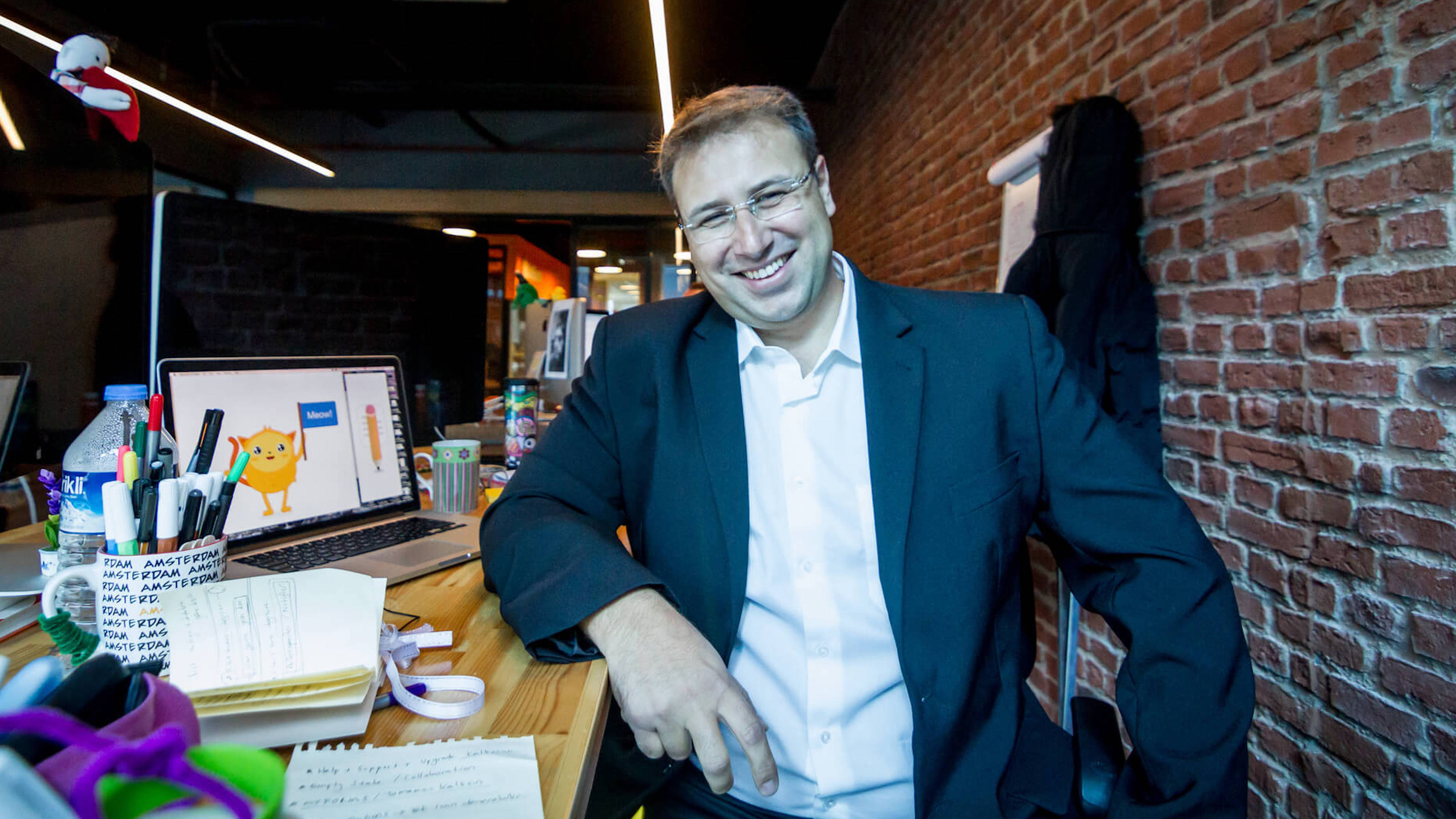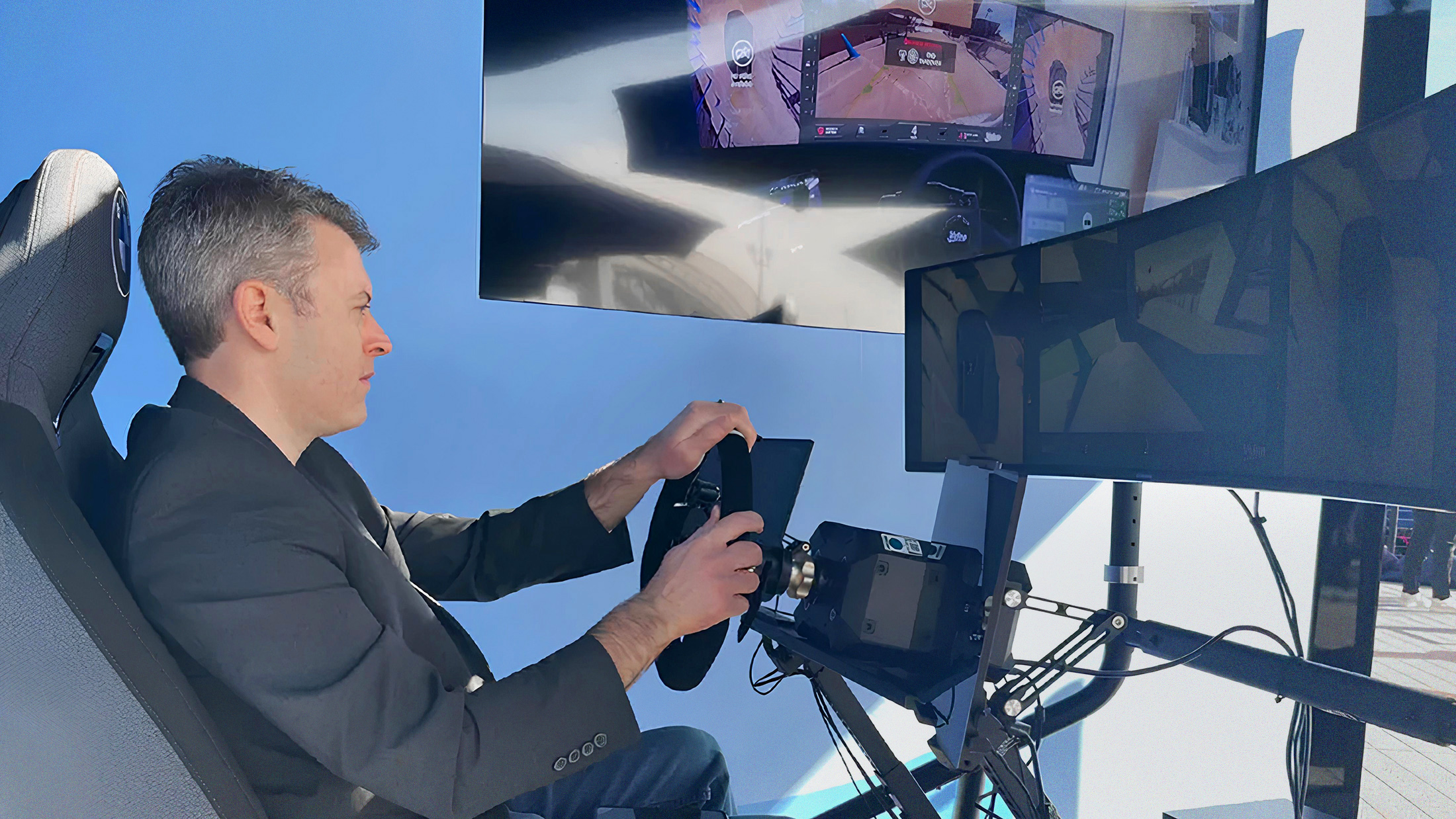Speeding up science

When you think of a scientist at work in a lab, you might visualize a familiar stereotype: Someone in a white coat, possibly wearing goggles, rubber gloves, and maybe a mask for protection. They’re transferring liquids from container to container, using droppers and pipettes to do the work, subjecting those samples to different conditions, and then maybe looking at the results under a microscope.
It can be a painstakingly slow process, but it mostly works.
For years now, robots, or some other form of automation, have also been working in labs, speeding up that slow process, sparing scientists and assistants from the monotony, making experiments move along exponentially faster.
But even then, robots could still generally only test for one variable at a time.
Markus Gershater had an idea: What if we could teach those robots to not only work faster, but to test for several, or even many, variables at a time? What if the process could be sped up to seven, ten, or even hundreds of times faster than the old way.
That’s why Gershater and a friend founded Synthace, a London company that builds software to accomplish that very purpose. They have branded the software Antha, described as a program that “gives biologists sophisticated, flexible and integrated control over lab hardware.”
As a result of such advances, scientists, pharmaceutical companies, and medical researchers are learning and developing things that can treat and even cure diseases and conditions that might have otherwise taken years, or decades.
ORBITER caught up with Gershater, the Chief Scientific Officer at Synthace, to learn more about the science and what it means for the rest of us.
ORBITER: How did you get into this field?
Markus Gershater: I’ve always known that I wanted to be a biologist. Throughout my career, it’s gone from the pure investigation of biology to asking, “How can we harness the powers of biology to do beneficial things?”
Markus Gershater
Biology is a really complex system—the most complex thing in the known universe. Throughout my career, especially in the early days, you go into a lab, and there are inherent assumptions about how people work: “Do it this way” or “You need to do this at that temperature” or “Keep this bit on ice.”
But there doesn’t seem to be a huge amount of knowledge as to why. I’m one of those irritating people who questions everything. We use so many protocols in the lab where we’re trying to investigate this hugely complex system, using methods that built up over time, but it doesn’t necessarily mean something has been exhaustively investigated.
For someone like me, that can be intensely frustrating. Especially when those protocols don’t always work.
What’s the story behind co-founding Synthace in 2011?
It started while I was doing a post-doctoral position at University College London, where I was working on biotransformation. That’s where you take an individual enzyme, an individual catalyst, and see what you can do with it. I was investigating how you could string many of them together, getting a cascade of these reactions, all building one on top of another to make more profound changes to molecules.
I was trying to take enzymes out of plants, to get them to be produced in E. coli in a lab bacterial strain. But exactly how am I going to write this DNA code to put into the bacterial strain? Today, we can read and write DNA almost at will, but not at that time. Working out how to write the fundamental code of life to get a particular outcome, this is a very difficult problem to solve!
I needed a way to do this more systematically. Doing this just with the human brain and a pencil and paper just doesn’t cut it. You need more sophisticated computational analysis.
I met another researcher at UCL, a chap named Sean Ward who was analyzing patterns of DNA code. Sean had a computational background, and I was coming from my biology background. Together we founded Synthace because we were convinced there should be better ways of addressing the complexities of biology, via multifactorial experimentation.
What better ways did you come up with?
In high school biology, you’re taught to ask one question at a time: If you want to investigate whether something’s affecting your biological system, you need to hold everything else constant and just investigate that one thing. That’s called a “fair test,” and it has become conflated with the scientific method as a whole. The implication is that if you’re not just looking at one factor at a time, you’re not really doing science. You’re not doing rigorous experiments. But that’s a fallacy.
There are ways to set up very structured, rigorous experiments which look at a large number of factors simultaneously. So I started using these methods, and found that they can be incredibly powerful. In my previous job, using these methods, I got a seven-fold increase in yield in three weeks of lab work. That’s a 700% increase. That blew me away.
So we started Synthace by leaning on these findings, with the conviction that things could be done in a better way.
If you think about what biology is, it’s almost inevitable that this is a better way of working. Evolution works such that it will stack up lots of different changes in order to get a particular effect. It’s very opportunistic. If there’s a combination of three different features of a cell that can be beneficial to that organism, then evolution will start selecting on that.
For pretty much every aspect of biology, for every aspect of who we are as people, it is a complex combination of our genetics and the environment we’ve grown up in. This then correlates with biology in the lab. If we are looking to make a pharmaceutical in a set of cells, then the way we program those cells using genetic engineering will profoundly impact the product it’s going to produce—but in conjunction with what we feed those cells, how much oxygen we give them, what temperature we incubate them, all these sort of things. The problem is that, if biology is being done in this one factor at a time method, you miss all of these interconnections. You miss the fundamental emergent nature of biology. So we started Synthace with the idea of, “Let’s try to address biological complexity with more sophisticated types of experiments, where we’re looking at lots of things simultaneously.” It’s actually a much more holistic way of looking at biological systems. They’re very complicated experiments, but you can do them.
We were working with pharmaceutical companies like Merck, and Dow AgroSciences back in those days. They were giving us ever more challenging problems to deal with, needing ever more complex experiments—sophisticated matrices of experiments. As you add more factors to experiments, you don’t just add a few more runs. We were ending up doing thousands of experimental runs simultaneously, where every single one of those runs was different. And that just becomes exceptionally arduous to carry out.
In the past, these complex experiments were done largely by hand, but we figured we should be able to use automation to help. But the issue with automation is that it’s fundamentally set up to do the same thing over and over again—you program a robot, and it’ll faithfully do exactly what you programmed it to, no more, no less.
Speaking of programming, talk about Antha.
When doing research, each experiment is composed of thousands, if not tens of thousands, of individual steps—which is basically where you’re pipetting liquids about—like the vast majority of biological research. You can get a robot to do this, but you have to tell it every single pipetting set that you want it to do.
So automation by itself isn’t the solution. You also need a much better way of programming that automation. That’s when we turned from a company which was fundamentally all about, “How can we do these complex experiments to address biological complexity?” to, “How can we actually make a software layer that’s going to allow us to flexibly reprogram automation in order to do the experiments?” We were looking to make a step change in the scale of experiment that we’re able to do.
The analogy I give is that in our day-to-day life, we’re used to interacting with really complex hardware but in a really intuitive way. Your average smartphone or laptop is incredibly complex hardware, but we don’t think about that when we’re using it. That’s because there’s a layer of software applications and operating systems which lie between us and the hardware, which then do all of the orchestration for us.
In the lab, we have a similar situation: We have really sophisticated hardware, but we don’t have that software layer that helps us orchestrate that hardware, to realize our intent for a particular experiment.
In 2014, we realized this was our main opportunity. We had built some internal technologies which helped us to program robots, but our clients were really interested in having that capability themselves. So we set about making a software product to help people flexibly automate whatever biological R&D they’re doing in their lab. And that software product is Antha.
So these aren’t just computer programs running theoretical experiments, but using automation to do the job that humans have always done—taking pipettes and putting fluids in different tubes. Actual tangible biology is still taking place.
Right. That’s fundamental to who we are as a company. We are a biology company first and foremost. We’re all about asking, “How can we run the experiments that allow us to ask the questions of biology which we need to ask in order to really understand what’s going on?” And given the complexity of the biological systems we’re dealing with, it’s amazing that the field has got so far with running experiments just by hand.
We are directly looking at optimizing biological systems and solving biological problems. We have actual labs at Synthace. This is how we know we’re making software which is genuinely helpful. We’re not the software company who thinks we know better. We’re a company that has encountered the difficulties of trying to address biological complexity, and we’ve made tools here that helped us with that. It was then a subsequent realization that we thought this this could be a good business model.
You said that at first you were able to do experiments seven times faster than before. What about now?
Since then, our best case study was 200-fold improvement. So this can be incredibly potent.
Are labs and companies on board with the idea?
Many are. But some say that this isn’t really the way that biology has traditionally been done—that biology should be done predominantly one factor at a time. The biologist thinks, Okay, what could affect my system? It could be temperature. And they spend a week looking at their process at many different temperatures, and they’ll be like, “Okay, 34 degrees seems to be the best temperature. Now what if I fed it some more sugars? What effect will that have?” The problem with that approach is that, if the optimum sugar feeding strategy depends on the temperature, then you’re not going to find that, because you’ve only investigated it at a single temperature.
Fundamentally what we’re looking to do is, using the automation, make a much more sophisticated experiment a lot easier to do.
3D illustration of T-cells attacking a cancer cell (CAR T-cell therapy)
We work with a number of clients, ranging from traditional pharmaceutical companies to cell and gene therapy companies. The gene companies are looking to find ways to modify genetics with the aim of curing people of muscular dystrophy or various blindnesses.
We work with cell therapy companies, doing things like CAR T-cell therapy, which can attack cancer cells. These companies are working with kids who have leukemia. The treatment regime is that you take immune cells from their blood, isolate those cells, and then engineer them to recognize the cancer in their bodies. You’re basically reprogramming the immune cells so they will seek out and destroy the leukemia cells. And it’s had some startlingly effective results; some of these kids have gone into complete remission, so it’s effectively a cure.
What’s Synthace’s role in that picture?
To modify those immune cells, you need a way of getting the DNA into them, using something called a viral vector. It’s taking the capability of viruses to get DNA into human cells by stripping away all of the pathogenic parts of the virus, the bits that are detrimental. And then packaging up the DNA in these now completely safe viral vectors, which deliver the DNA into these cells and enable them to be re-engineered to cure these cancers.
But making these viral vectors, and making them effective, is very difficult. We’ve been working with a company, Oxford Biomedica, that makes these viral vectors to help kids with leukemia. And they’re using our Antha software in a number of different ways; one case study shows how Antha made about a tenfold improvement in that process. You can imagine how deeply exciting that is for us: We’re effectively producing tools to help biologists do their work better.
Biologists have better things to do than laboring in a lab. We want them to be thinking about how to design their experiments and how to interpret their results. And we want them to be thinking about their science, not thinking about how to pipette a liquid from one place to another. It’s a profound misuse of their skills.
So, to clarify: Synthace doesn’t build the robots or automation that does the lab work, but just the software?
Right. We don’t make equipment, but a lot of suppliers make very good automation equipment. We supply software which helps to orchestrate the functionality of that equipment in a much more sophisticated way. Our software talks to a range of different automations and lab equipment that’s already out there, so that can do these much more sophisticated experiments and gain much more rapid improvements.
Some of the most gratifying feedback we’ve had is when we ask them how long it would have taken them without our software. And some say, “Well, we couldn’t have done it.” So it isn’t just a matter of taking longer; sometimes they couldn’t do the work at all.
Let’s zero in on the term synthetic biology.
I have mixed feelings about the term synthetic biology. I prefer the term engineering biology. It still has overtones of man-made, but it’s more deliberate: “How can we go about making very deliberate and careful changes within the biology for a very predictable outcome?” That’s really what the field is striving for.
Synthetic biologists aspire to being able to predictively and systematically engineer biological systems to give us really beneficent outcomes. One example is CAR T-cell therapy—a very deliberate reprogramming of those immune cells to kill cancer. That’s not something that you just happen on by chance. It’s done with real design in mind.
This technology and science obviously has the potential for great good, but in the wrong hands, there’s also the potential for misuse. What are some of the potential ethical issues that could arise? In the wrong hands, anything’s possible.
This is something we’ve thought about for a long time. You have to, if you embark on this kind of endeavor of engineering life. You’re working with some of the most fundamental things that impact our lives. You have to take these things seriously.
I’m not going to pretend that there’s some easy solution. We are making biology easier to engineer, and like you say, that has possibilities in all directions, just like any technology does. It’s almost inevitable that things will happen that could be exceptionally dangerous for humans—most likely, some kind of outbreak of disease. If we think about previous influenza pandemics which can kill huge numbers of people, that’s a truly scary prospect.
But to my way of thinking, this makes it a moral imperative to do what we’re doing. We haven’t had a pandemic for a while, but there’s no reason it couldn’t occur at any time. And the faster we can make tools which can rapidly generate responses to those kind of pandemics, the better.
Ultimately, if biologists are given the tools to address biological complexity as rapidly as possible in order to create vaccines and cures, all the better.
Even for threats that just occur from nature, which can be a pretty brutal place. Now we’re starting to have the capabilities of holding our own corner against various things.
I think we should be using the technologies like the ones we’re creating. Ours is just one of many tools that need to come together for the kind of world where we can rapidly engineer biology to meet these threats. And when there are bad actors, people that may use these technologies in a way we wish they wouldn’t, then we have the infrastructure to cope with those.
That isn’t a perfect answer. But I’m not going to pretend that there are easy answers.
If we imagine ourselves into a world where this kind of technology is commonplace, then the likes of governmental organizations and healthcare organizations will have a huge amount of this kind of equipment at their disposal, which they’d be able to bring to bear against any emerging threat. Whereas any bad actors are very unlikely to have that same kind of resource to create a threat in the first place. So I believe it still puts most of the power on the side of the sane, on the side of the good.
The post Speeding Up Science appeared first on ORBITER.





